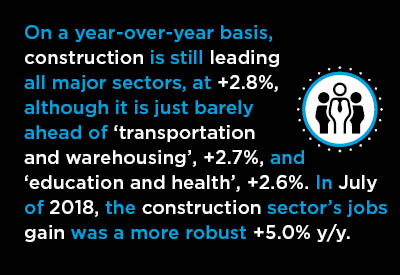Fed Becomes Erratic in Response to Unorthodox Economic Policy
After achieving +3.1% GDP growth in Q1, the U.S. economy stayed healthy in Q2 at +2.1%. In July, according to the latest ‘Employment Situation’ report from the Bureau of Labor Statistics (BLS), +164,000 net jobs were created in America, on top of a +193,000 gain the month before.

The unemployment rate continues to sit at an exceptionally low 3.7%. Inflation is a little less than +2.0% year over year. All in all, the U.S. economy is in extraordinarily good shape.
How is the Federal Reserve responding? It just lowered its key policy-setting interest rate by 25 basis points (100 bps = 1.00%). It has also suggested that further cuts are no sure thing.
Orthodox economic policy would see a strong U.S. economy raising other economies around the world. Orthodox policy would permit relatively free ‘goods’ flows internationally, resulting in better global trade and heightened demand for commodities. A ‘rising tide would lift all boats’.
The Uncharted Waters of Unorthodox Economic Policy
Unorthodox economic policy, which is what currently prevails in America, seeks to restrain the growth prospects of the next largest economy, China, through the imposition of tariffs in order to win concessions on market access and protection of intellectual property. (Orthodox economic policy would pursue those entirely legitimate goals through behind-the-scenes negotiations.)
When the pursuit of unorthodox policy leads to slowdowns in Europe and China, there is talk of stimulatory interest rate cuts in those locations. This has led to pre-emptive action being initiated in the U.S. to weaken the value of the dollar and support the export sales of manufacturers.
Unorthodox economic policy would see an initial round of punitive tariffs imposed on Chinese goods be followed by next waves of ratcheting-higher tariffs, knowing the Federal Reserve will attempt to counter whatever negative fallout there may be through additional interest rate relief.
Orthodox economic policy is for the Fed to move on interest rates in reaction to real economic data on employment and inflation. Unorthodox economic policy has the Fed giving stock market investors what they want and appearing to be susceptible to instructions from the President.
An erratic and less than independent Federal Reserve will not serve America’s best interests.
Average Monthly Jobs Gain Down by One-Quarter
The average monthly employment gain in the U.S. so far this year has been +165,000 jobs. While that’s still a commendable increase, it is a drop of more than one-quarter (-27.2%) when compared with 2018’s average figure for January-July of +227,000. 2019’s average suffers from poor showings in February (only +56,000) and May (+62,000).
Construction employment in July limped ahead by only +4,000. The average monthly construction jobs gain to date in 2019 is half what it was for the same period last year, +15,000 down from +30,000.
Manufacturing employment has turned in an even worse performance. Production-line jobs this year have averaged a meager +8,000 versus +23,000 in 2018, a decline of two-thirds (-66%).
On a year-over-year basis, however, construction is still leading all major sectors, at +2.8%, although it is just barely ahead of ‘transportation and warehousing’, +2.7%, and ‘education and health’, +2.6%. In July of 2018, the construction sector’s jobs gain was a more robust +5.0% y/y.
Construction employment is currently being hampered by a flatlining of housing starts and, as has been the topic of much discussion throughout the industry, an extreme shortage of qualified workers. The not seasonally adjusted (NSA) unemployment rate in construction in July was 3.8%, an improvement on June’s 4.0%, but a small reverse step from July 2018’s 3.4%.
In a couple of sectors, the year-over-year jobs record is now negative ‒ retail, -0.4%, and information services, -0.5%.
Government hiring over the past year has been unremarkable, at +0.4%.
Earnings Growth is Beating Inflation, but the Race is Unexciting
The average hourly earnings increase for all jobs in America in July was +3.2% year over year. The average weekly compensation climb was +2.6%.
As a subset of ‘all jobs’, construction workers did not fare as well either hourly, at +2.8%, or weekly, at +2.0%.
Setting aside supervisory personnel and concentrating on production workers only, the average hourly earnings increase across all industries in July was +3.3%. The average weekly gain was +2.4%.
Again, construction workers fell behind, both hourly, at +2.5%, and weekly, +1.4%.
The latest published ‘all-items’ inflation figure for the U.S. was +1.6%, as recorded in the Consumer Price Index (CPI) report for June.
Earnings levels are generally rising faster than inflation, but the race is much less exciting than it should be this far along in the economic upturn.











Recent Comments
comments for this post are closed